VPN.asia Review
VPN.asia has a sleek interface and fast speeds, but it's lacking in features and can't access most streaming services. Find out if it's worth it in this updated VPN.asia review.
Since our last VPN.asia review, some things have improved quite a bit. The interface has been updated to be a bit more compact and looks much sleeker, though that wasn’t much of a problem to begin with.
What’s more important is that speeds have improved tremendously, making it much more usable than the last time we checked in. However, if you’re not planning on torrenting, there’s no advantage to these speeds, since the VPN is still blocked by most streaming services.
Despite these improvements, there’s still a lot lacking, which will keep VPN.asia off our best VPN list for now. There are still next to no features on the desktop client, and the customer service is still among the worst we’ve seen.
While the low price may be tempting, there are better and even more affordable options, so read on to see where VPN.asia trips up and what we recommend instead.
Protect Your Privacy. Get Our Free VPN Guide Now!
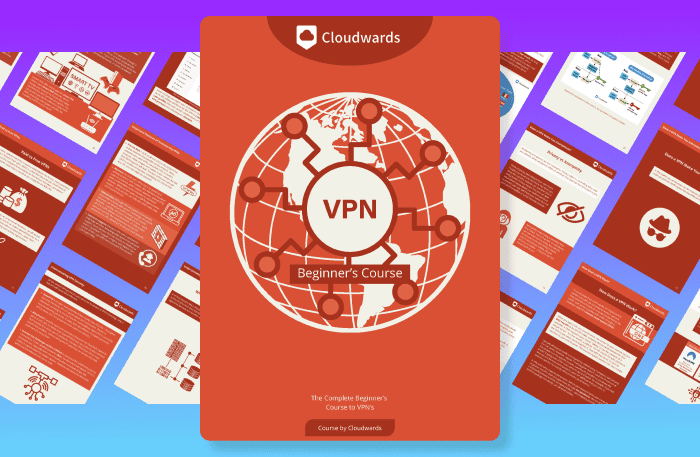
- Comprehend the essential role a VPN plays in safeguarding your digital life
- Gain a deep understanding of how VPNs function under the hood
- Develop the ability to distinguish fact from fiction in VPN promotions
VPN.asia Pros & Cons
Pros:
- Very fast
- User-friendly interface
- Fairly affordable pricing
Cons:
- Lacking in features
- Didn’t unlock streaming apps
- Very slow customer support
Features: What Can VPN.asia Do?
VPN.asia has a simple settings menu that is broken down into only two pages, both of which are sparsely populated. (For comparison, you can look at our Private Internet Access review, where PIA had six pages of settings, each of which have more on it than VPN.asia offers in total.)
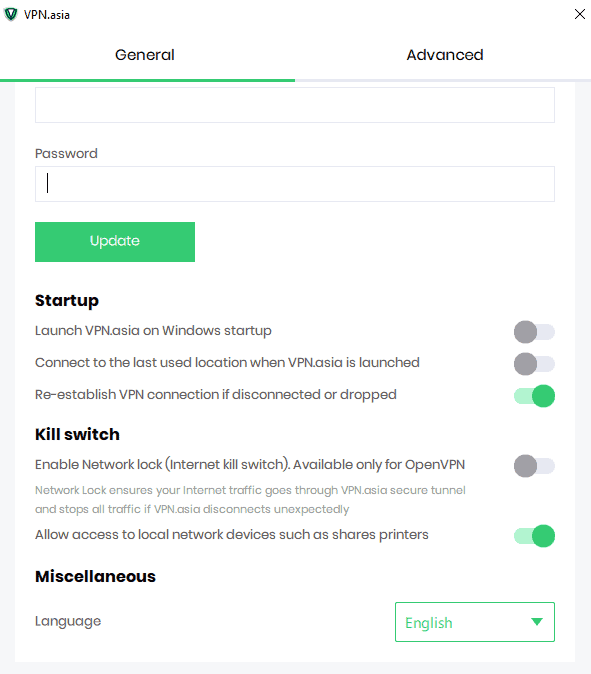
The first page, simply labeled as “general,” contains a few toggle switches for things like launching the VPN automatically on startup and auto-connecting to the last location you used. While this is a must-have, basic feature for security, it would be nice to choose the server location when it connects automatically.
On this “general” page, there is also an option for having the VPN reconnect on its own if the connection to the VPN is lost. At the bottom of this page is a kill switch option and, finally, a setting that allows you to still connect with and use local network devices, such as wireless printers.
The second page of VPN.asia’s settings is labeled “advanced” and is even more barren than the first page. Here, you can choose which protocol you want to use. This is something we’ll look at in more detail later in the “security” section of this article.
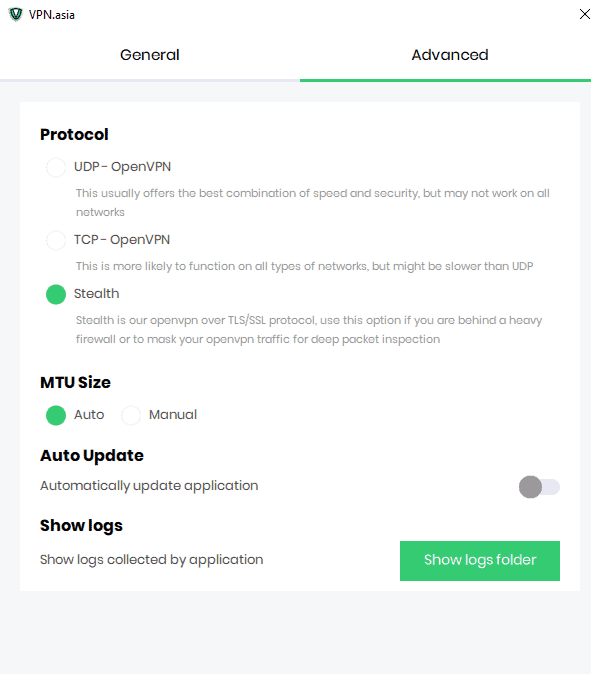
Below this is an option to change the MTU (maximum transmission unit) size, which can help with connection stability and troubleshooting in rare cases.
The only other things found on the advanced page are options to automatically get updates for the software, which is off by default for some reason, and access to a logs folder that is most likely something support will ask for if you’re having trouble.
VPN.asia covers only the bare minimum in terms of features and fails to deliver any extra bells or whistles. One of the most notable things lacking is split tunneling, which is something you can read about in our ExpressVPN vs CyberGhost article (both of these providers have excellent yet very different implementations of split tunneling to benefit a variety of VPN users).
If the VPN added split tunneling and proxy settings — like we saw in our TorGuard review — or more choices of protocol and encryption, it would all go a long way toward improving VPN.asia’s feature set.
VPN.asia Features Overview
| Features | |
|---|---|
| Payment methods | PayPal, Credit card, Bitcoin |
| Accepts cryptocurrency | |
| Simultaneous connections | Unlimited |
| Supports split tunneling | |
| Unlimited bandwidth | |
| Free trial available | |
| Refund period | |
| Worldwide server amount | 40 servers in 30 countries |
| Desktop OSes | Windows, MacOS, Linux, Chromebook, Xbox, Playstation |
| Mobile OSes | Android, iOS, Apple TV |
| Browser extensions | |
| Can be installed on routers | |
| Can access Netflix US | |
| Can access BBC iPlayer | |
| Can access Hulu | |
| Can access Amazon Prime Video | |
| Encryption types | 256-AES |
| VPN protocols available | OpenVPN, PPTP, L2TP |
| Enabled at device startup | |
| Allows torrenting | |
| No-logging policy | |
| Passed DNS leak test | |
| Killswitch available | |
| Malware/ad blocker included | |
| Live Chat | 24/7 |
| Email support | 24/7 |
| Phone support | |
| User forum | |
| Knowledgebase |
Pricing: How Much Does VPN.asia Cost?
VPN.asia keeps things pretty simple when it comes to plan options. It offers only one plan in three different time frames, ranging from monthly to biennial.
The monthly plan is pretty competitive, coming in well below many top-shelf competitors and more in line with what we saw in our Mullvad review (which is a solid deal for a month-to-month VPN subscription).
- Yes
It’s worth noting that VPN.asia seems to have a permanent sale; the “normal” pricing it lists for the monthly, one-year plans and two-year plans are $5.99, $41.88 and $59.76, respectively.
Even with the discount, the longer-term plans don’t actually provide too much savings. The two-year option brings the per-month cost of the monthly plan down by only a couple and a half dollars, from $5.99 to $3.49.
This is pretty weak long-term pricing when compared to something like what you’ll see in our NordVPN review. NordVPN offers two-year plans that bring its base $12.99 monthly price down to a mere $3.01. Not to mention, NordVPN offers much better features and more servers, and it is just generally better than VPN.asia.
VPN.asia doesn’t have any kind of free trial or plan, so it isn’t eligible for our best free VPN list. However, it does have a seven-day money-back guarantee. While this might sound good, it actually falls well short of what has largely become the industry standard of a 30-day money-back guarantee.
Finally, for payment methods, VPN.asia is reasonably flexible. You can choose to pay with PayPal, Coinbase or credit card. There are also a few third-party payment options available, such as Mint.
While it doesn’t have the best long-term pricing and needs to beef up its relatively brief money-back guarantee, VPN.asia overall falls somewhere in the middle of the field when it comes to cost, thanks largely to its affordable monthly option.
User-Friendliness & Hands-On Testing
Due in part to its overall lack of features, VPN.asia is quite simple to use. When you first load up the software, you’re greeted with a pretty sleek interface. At the top you’ll find your selected server location, along with some connection metrics and a large power button that will connect or disconnect you from the VPN.
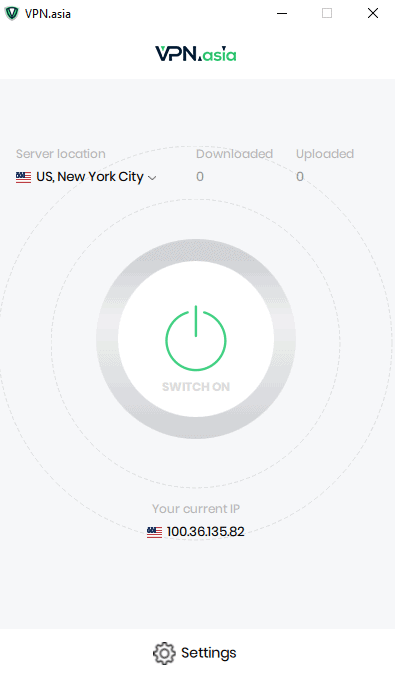
Clicking on the server location opens up the server list, which could definitely use some improved organization. The list of locations does not seem to be alphabetized or sorted in any way we could discern for that matter. The first location at the very top of the list is Dubai, followed by Sydney, so they don’t seem to be organized by country, city or even by region.
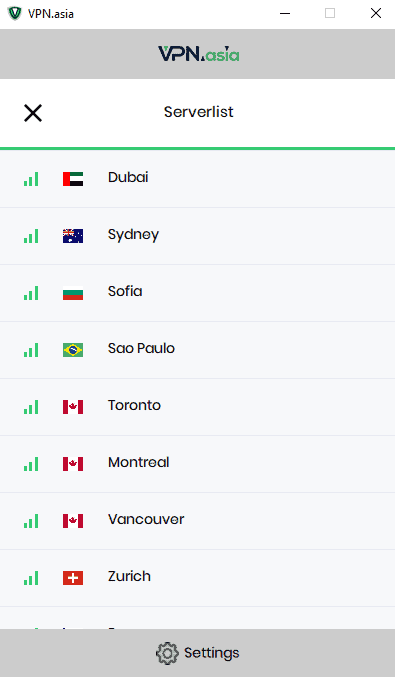
There is also no search bar, meaning that if you want to find a specific location, you have to manually search the list to see if it’s there. Aside from this, the UI is pretty sleek, offering a visually pleasing white-and-green color scheme paired with a modern style.
The settings menu is easy to navigate, thanks in no small part to the limited options, as we mentioned earlier in the “features” section. With only two pages of options, it’s easy to find the setting you’re looking for, and some of the options have small explanations of what they do.
It would be difficult to find a more plug-and-play VPN than this. VPN.asia’s interface is intuitive enough that anyone could use it, but the server list really needs some cleaning up.
VPN.asia Speed
To see how powerful the VPN.asia servers are, we ran a speed test in five different locations and compared it to our baseline speed when not connected to the VPN. Overall, VPN.asia performed surprisingly well, giving us about half of our unprotected download speeds or more in every location we tested.
| Location | Ping ms | Download Mbps | Upload Mbps |
|---|---|---|---|
| Unprotected | 3 | 291.25 | 329.35 |
| U.S. | 12 | 222.82 | 248.27 |
| UK | 78 | 136.24 | 206.71 |
| Brazil | 128 | 177.39 | 32.50 |
| Germany | 94 | 136.55 | 199.22 |
| Japan | 169 | 143.43 | 108.47 |
| Average | 96 | 163.29 | 159.03 |
Speeds such as these would actually make VPN.asia a contender for torrenting, as it would be able to download shows or movies pretty quickly if there are plenty of seeders for the torrent.
Every server we tried had very minimal delay and was able to play HD video in 1080p — and even 60fps — without any buffering or issues. The only server where we saw any difference was the Brazilian server, which had the lowest upload speeds by far.
Things still loaded quickly on the Brazilian server, but videos would default to 720p rather than 1080p, like all of the other servers we tried. This isn’t a huge issue, and if we manually set the resolution to 1080p it would still work just fine, but it is a notable difference.
That said, it’s still not quite as fast as some of the top-shelf options out there, and is just out of reach of our fastest VPNs roundup.
Security: Is VPN.asia Safe?
Things didn’t start off well for VPN.asia. When we went to install the desktop client on our computer, we were met with an ominous blue screen telling us that Windows Defender prevented the app from running.
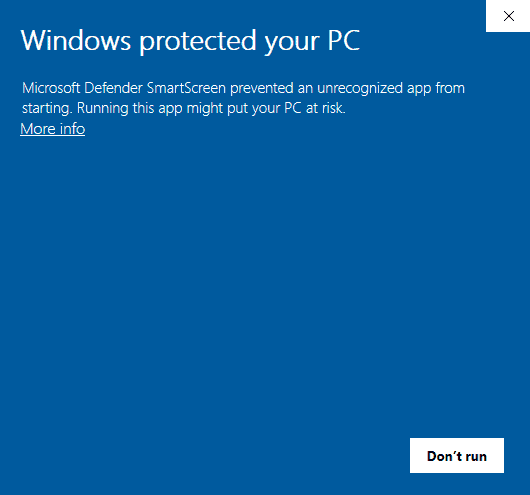
We later scanned the program and found nothing suspicious, so this is most likely due to Windows not recognizing the software license or publisher information, but this is still a bad way to start things off.
As we mentioned earlier in the “features” section, VPN.asia has three options for protocol, but all of these are different types of OpenVPN. If you check out our VPN protocol guide, you can see that OpenVPN is a solid choice when it comes to VPN security and is widely considered the gold standard, but having some options is definitely nice.
An additional protocol, such as more cutting edge WireGuard protocol, would have been a nice addition. However, VPN.asia does seem to include some form of semi-proprietary protocol that is labeled “stealth” in the settings.
This seems to include some kind of obfuscation to get around stronger firewalls, similar to the Chameleon protocol we saw in our VyprVPN review. As for encrypting your files, VPN.asia locks you into AES 256-bit encryption, which is a very solid choice when combined with the OpenVPN protocol.
Between the choice of protocol and encryption, it’s pretty safe to say VPN.asia is a decently secure VPN. We weren’t able to detect any IP or DNS leaks during our testing, which helps confirm this. While it could offer more customizability and options, it has settled for simplicity.
Privacy: Does VPN.asia Keep Logs?
The VPN.asia privacy policy is pleasantly short, though not the most clearly written policy we’ve come across. It has a no-logging policy and does not collect or record any information about the use of its VPN service.
It does collect some information on the website through the use of cookies; however, this is a practically inescapable practice used on nearly every website you’ll ever visit. This information is used to maintain the site and to gather basic information about the kinds of people visiting.
The only concerning thing we saw in the privacy policy was the mention that it could share some anonymous or aggregate data with third parties for marketing purposes. It’s not entirely clear what this means, but it’s never good to see anything about third parties getting information, even if it is non-identifying.
VPN.asia Streaming Performance & Unblocking Ability
Streaming performance was a weak point for VPN.asia. Hulu, Amazon Prime Video and BBC iPlayer all blocked us while we were using the VPN. We also tried using the “stealth” protocol to see if it made any difference, to no avail.
Netflix seemed to work at times, but at other times would simply not load at all. Despite having the bandwidth to make this a good VPN for streaming, it seems to be unable to consistently access any geoblocked content.
If you’re looking for a reliable VPN to use for streaming, be sure to check out our best VPN for Hulu, Netflix, Amazon Prime video or BBC iPlayer articles, depending on which service you’re after.
VPN.asia VPN Server Locations
Despite the name, VPN.asia does not seem to be catering to any one area or continent. On its website, it boasts a server network with more than 40 servers in 30 countries. While the distribution of these servers is solid — covering Asia, North America, South America and the Middle East quite well — the overall number of servers is underwhelming.
For reference, you can look at our HideMyAss review, which looked at a server network with thousands of servers in more than 190 countries. One of the main problems with having so few servers in the network is that more servers means more overall bandwidth.
With such a limited number of servers, a spike in users or traffic could cause a major slowdown from the solid speeds we saw earlier. A network with thousands of servers like NordVPN or HideMyAss will be able to distribute any unusually heavy loads and handle them more gracefully without any slowdown.
VPN.asia Customer Support
Customer service with VPN.asia is a mess. It advertises that it has fast support and even touts 24/7 “internet chat” representatives, but we were not able to get a hold of anyone. On the support page, there are three options for contacting VPN.asia, with the one in the center saying that live chat is online.
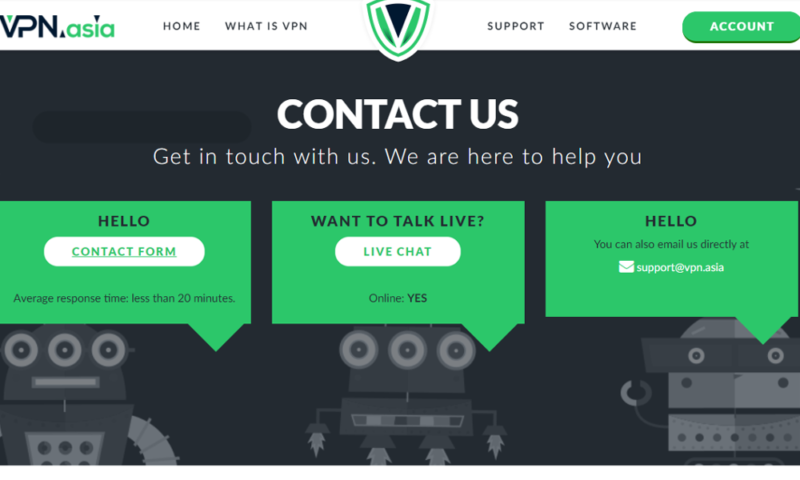
However, when we clicked this button, nothing happened. We were not taken to live chat and could not connect to anyone from this page.
If you click on the option to fill out a contact form, there is a bubble in the bottom right that appears to be for the live chat support. Again, there seemed to be nobody on the other end, as we never got a reply; however, we got an automatic message asking us to enter our email and wait to hear back.

We sent contact forms and contacted the live chat support but have still not heard back from either one. Luckily, the VPN is very simple and there is some information about installation available on the website. However, this complete lack of any customer support, despite flaunting 24/7 chat on the homepage of the website, is pretty upsetting.
The Verdict: Is VPN.asia a Good VPN Service?
While VPN.asia has made strides in the right direction, specifically with its much improved speeds, it still falls short in a number of areas in this VPN.asia review.
The lack of split tunneling — or features in general — definitely hurts its standing, but the abysmal customer service is just as bad. When you add the inability to access most streaming content to that, VPN.asia does not seem like a strong option, even at the decent price point it offers.
Have you used VPN.asia before? Did you have trouble connecting to geoblocked content like we did? Were your speeds as good as ours? We’d love to hear from you in the comments below. As always, thanks for reading.
FAQ
- VPN.asia’s “normal” pricing has the monthly, six-month and one-year plans costing $9, $45 and $69, respectively. However, there seems to be a permanent discount, so those same plans cost $5.99, $29.99 and $49.99, respectively.
- VPN.asia was unable to consistently access any geoblocked content on Netflix. Additionally, Hulu, Amazon Prime Video and BBC iPlayer all blocked our access while we were using the VPN.


